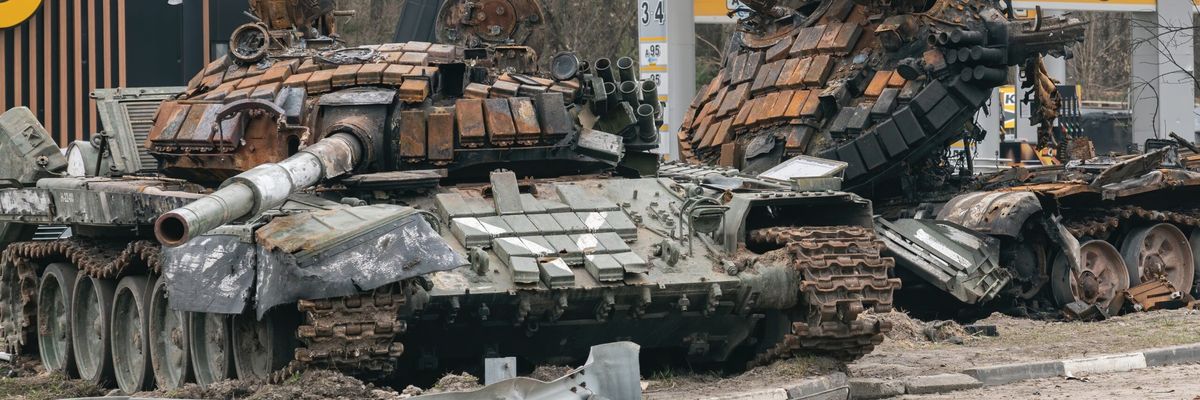It is not surprising that much has been written about the illegality and illegitimacy of Russia’s war aims in Ukraine. After all, seeking to annex parts of Ukraine or overthrow its legitimate government are flagrant violations of international law. Less has been written, however, about why Russia has failed so miserably to reach its main political — and not just military — objectives in Ukraine since the country’s revolution of 2014.
A key reason is that the Russian government pursued two mutually contradictory goals in Ukraine. On the one hand, Moscow sought to retain influence over Ukraine as a whole. On the other, it sought the “return” to Russia of territories that it considers historically Russian.
That contradiction has been resolved. From now on, Russia’s goal is land in the south and east. As to the rest of Ukraine, Russia will still try to keep it from formally joining NATO, but Russian elites with whom I have spoken now accept — as Putin himself presumably accepts — that it will be an enemy of Russia and a de facto ally of the West for the foreseeable future.
The origins of this dual policy can be traced back to a famous 1990 essay by Alexander Solzhenitysn — whose writings are said to have had considerable influence on Vladimir Putin — entitled “Rebuilding Russia.” With the Soviet Union evidently collapsing, Solzhenitsyn wrote that the Baltic, Caucasian, and Central Asian republics (minus Kazakhstan with its huge Russian minority) should simply leave, as they had different cultures and had never been part of Russia proper.
He had hoped that Ukraine and Belarus, as east Slavic peoples closely linked to Russia, would remain in some form of union, and called their separation “a cruel partition.
However, according to Solzhenitsyn, if a majority of Ukrainians truly wished to separate from Russia, they should be allowed to do so, but without "those parts that weren't part of old Ukraine ... Novorossia (“New Russia”), Crimea, Donbas and areas practically to the Caspian Sea." These areas, he wrote, should be allowed “self-determination,” implying that they would “rejoin” Russia.
Typically for such claims in modern history, the Russian claim to these territories is based on a contradictory mixture of historical, ethno-linguistic, and quasi-legal arguments, with democracy thrown in when useful. The basic case is that, until the late 18th century, these territories were empty steppe, depopulated by the raids of the Crimean Tatars to the south.
They were conquered by the Russian imperial army, and then settled by different colonists among whom ethnic Ukrainians predominated, but who also included many Russians, Germans, and Serbian, Bulgarian and Greek migrants from the Ottoman empire. No cities had existed in this region before the Russian conquest, and the newly founded ones were given new names, mostly those of Russian tsars. Today’s Dnipro was Yekaterinoslav; today’s Kropnytsky was Yelisavetgrad, before becoming Kirovgrad under Soviet rule. Mikolayiv was Nikolayev, after Tsar Nikolai I. Donetsk, curiously enough, was named Yuzovka after a Welshman, John Hughes, who first developed the coal mines of the region.
Partly due to the originally mixed settlement, and partly to industrial migration in the 19th and 20th centuries, this area has been largely Russian-speaking, and, until the Ukrainian revolution of 2014, voted consistently for parties favoring good relations with Russia. This region contains eight out of Ukraine’s 10 largest cities and the whole of Ukraine’s Black Sea coast. Its loss would leave Ukraine a rump state.
According to former Russian officials with whom I have spoken, the Kremlin was taken by surprise by the overthrow of President Yanukovych in February 2014, and thus scrambled to put together a response. No military plan was in place for an invasion of Ukraine, although, at that time, the extreme weakness of the Ukrainian army and the lack of a Ukrainian government meant that this may have been accomplished against little initial resistance.
The Kremlin appears to have expected a general spontaneous counter-revolution in the Russian-speaking areas (a precursor of the illusion that these populations would welcome this year’s invasion). But this happened only to a limited extent in the Donbas; and even there, it was only able to maintain itself with the semi-covert support of Russian troops.
Moscow supported the Donbas rebels but also signed the Minsk II agreement of 2015 whereby the Donbas would rejoin Ukraine with guarantees of full autonomy within that country. Moscow’s goal was that the region would then act as a force to defend Russian state interests and the position of the Russian minority within Ukraine. Recognizing this, the Ukrainian government, despite having signed the Minsk agreement, refused to amend the constitution to guarantee the region’s autonomy. Russia for its part took no steps to disarm the rebels.
While seeking influence in Ukraine as a whole, Moscow also annexed Crimea, which had been part of the Russian Soviet Republic until it was transferred to Ukraine by Soviet fiat in 1954. This annexation flatly contradicted the goal of maintaining Russian influence within Ukraine as a whole, which depended on keeping as many Russians as possible within Ukraine.
Crimea’s annexation, and the ongoing conflict in the Donbas, helped the authorities in Kiev to mobilize Ukrainian nationalism against Russia. Economic ties with Russia were broken; aided by the West, the equipment, training and morale of the Ukrainian army were vastly improved; and a series of laws were introduced greatly restricting the role of the Russian language in education, culture and public life.
By the summer of 2021, the Kremlin had become afraid that Ukraine was slipping irrevocably away from Russia. Putin’s strategy in response was heralded by his essay of July 2021, “On the Historical Unity of the Ukrainian and Russian Peoples,” in which he argued for the historical unity of the two peoples, denounced both Ukrainian nationalism and the Russian Communists for having created a separate Ukrainian Soviet republic, and wrote that true sovereignty of Ukraine is possible only in partnership with Russia.” However, he also raised territorial claims, quoting his former boss, St. Petersburg Mayor Anatoly Sobchak:
“[T]he republics that were founders of the Union, having denounced the 1922 Union Treaty, must return to the boundaries they had had before joining the Soviet Union. All other territorial acquisitions are subject to discussion, negotiations, given that the ground has been revoked.”
Putin would have been more honest had he added “discussion, negotiations — and war.”
This invasion plan was bedeviled by the same contradiction visible since 2014 and in Putin’s essay. Russia deployed fewer than 200,000 troops — far too few in any case to invade a country the size of Ukraine. Even more important, in pursuit of its two contradictory political goals, the Russian military divided its forces roughly equally between those intended to capture Kyiv, and those intended to occupy territory in the east and south. The first were intended to subjugate or replace the Ukrainian government and turn the whole of Ukraine into a Russian client state; the second, to seize as much Russian-speaking territory as possible in the east and south.
Largely as a result of seeking both these goals simultaneously and dividing its forces in this way, the Russian government failed completely at its first objective, and very largely at its second. On March 29, the Russian government announced that it was withdrawing its forces from around Kyiv; and, instead of a triumphant march across eastern Ukraine and the Black Sea coast, the Russian army has been reduced to a grinding war of attrition to capture small cities in the Donbas.
Moreover, this initial failure fatally undermined the war’s political goals. Russia’s ability to appeal to the population of eastern and southern Ukraine depended critically on a quick and painless victory. Instead, Russia has only been able to capture cities in the region by reducing them to rubble in months of fighting, and the invasion has been bitterly denounced by most local elected officials.
Nonetheless, Russia now seems determined to eventually incorporate as much of this territory as possible into Russia. Rigged referendums will be held, but the basic assumption seems to be that the population will settle down quietly under Moscow’s rule — which may prove just as much of an illusion as the Kremlin’s pre-invasion analysis of Ukrainian opinion.
Indicative of Russian plans has been the appointment of former Prime Minister Sergei Kiriyenko as Putin’s de facto governor of the conquered territories. Kiriyenko served previously as Putin’s chief of domestic political strategy.
There can be little doubt that the Russian government would still like to take all the mainly Russian-speaking areas of Ukraine, including the whole of Ukraine’s coastline. However, given the losses the Russian army has suffered and the slow progress it has made, this prospect is looking less and less likely in military terms. It is possible therefore that if Moscow can conquer the whole of Donetsk province (as it has just conquered the whole of Luhansk), it will stop and offer a ceasefire — but one under which the limited areas conquered by Russia will remain in Russian hands. This outcome would deal a serious blow to Ukraine — but also a bad blow for Russia, given how much more the Kremlin had hoped to conquer.

















